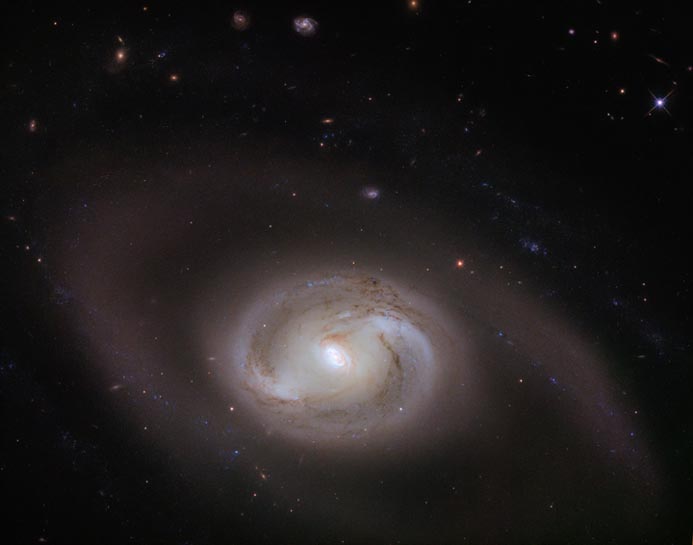
Spiral galaxy
RA 6h 50m 8.02s Dec 60° 51' 3.26"
Lynx
95 million light-years
11.7
3.65 x 2.1 arcmin
2.59 x 2.01 arcminutes
North is 6.8° left of vertical
ESA/Hubble & NASA, J. Greene
April 6, 2020
ABOUT
THIS IMAGE:
At first glance, the subject of this NASA/ESA Hubble Space Telescope image looks to be a simple spiral galaxy, with two pinwheeling arms emerging from a central bar of stars and material that cuts through the galactic center. In fact, there are rings within these spiral arms, too: spirals within a spiral.
This kind of morphology is known as a multi-ring structure. As this description suggests, this galaxy, named NGC 2273, hosts an inner ring and two outer "pseudo-rings" - having so many distinct rings is rare, and makes NGC 2273 unusual. Rings are created when a galaxy's spiral arms appear to loop around to nearly close upon one another, combined with a trick of cosmic perspective. NGC 2273's two pseudo-rings are formed by two swirling sets of spiral arms coming together, and the inner ring by two arcing structures nearer to the galactic center, which seem to connect in a similar way.
These rings are not the only unique feature of this galaxy. NGC 2273 is also a Seyfert galaxy, a galaxy with an extremely luminous core. In fact, the center of a galaxy such as this is powered by a supermassive black hole, and can glow brightly enough to outshine an entire galaxy like the Milky Way.
From Wikipedia:
NGC 2273 is a barred spiral galaxy located in the constellation Lynx. It is located at a distance of circa 95 million light years from Earth, which, given its apparent dimensions, means that NGC 2273 is about 100,000 light years across. It was discovered by Nils Dunér on September 15, 1867.
NGC 2273 has a multiring
structure. The galaxy has an inner ring and two outer pseudorings formed
by two sets of spiral arms. The galaxy is seen with an inclination of
41 degrees. The galaxy hosts about 1.1×109 M☉
of hydrogen gas (HI), with most of it lying at the outer pseudoring. The
galaxy also hosts large amounts of molecular gas, as indicated by the
CO lines, which is regarded as an indicator of active star formation.
The total infrared luminosity of the galaxy is 1010.25 L☉.
The galaxy has a bar whose radius is 40 arcseconds.
Observations of the central 20 arcseconds of the galaxy by the Hubble
Space Telescope showed spiral arms that corresponded to the inner ring.
The central ovoid of the galaxy was found to feature a bar-like structure
and two arc structures that form a partial nuclear ring. Its emission
is associated with the presence of HII regions. Around the nucleus lies
a dusty ring-like structure, with a radius of 7 arcseconds, better seen
at its northwest part. Another dusty ring is observed at 20 arcseconds
radius. Based on the emission lines that are present in its spectrum,
the nucleus of NGC 2273 has been characterized as active and it has been
categorized as a type II Seyfert galaxy. Also, a water kilomaser has been
detected in the nuclear region of the galaxy. It could be created either
by the active nucleus or by a prominent site of star formation.
Observations by BeppoSAX,
XMM Newton, and Chandra X-Ray Observatory suggested that the nucleus of
NGC 2273 is obscured by a Compton thick column, with high column density,
estimated to be 1.1×1024 cm-2 as measured by ASCA, or
1.5×1024 cm-2 as measured by Suzaku. The harder X-Rays
manage to get through and are dominated by reflection from cold material,
as the Fe-K line indicates. The spectrography of the nuclear regions is
weakly polarized, more prominent in H-alpha. The broad X-ray spectrum
of NGC 2273 has been found to be composed of a thermal or scattered soft
component, a reflected component, and an absorbed power law component.
The 2-10 keV X-ray flux of the galaxy is estimated to be 1.7×1042
ergs-1.
The nucleus also emits radiowaves. The radio source has been found to
be linear and is composed of two unequal radio features separated by about
170 parsecs. These two radio features have been identified as radio jets.
A linear jet-like feature extending for 2 arcseconds east of the nucleus
was observed in [O III] λ5007 images. It is aligned with the radio
jets and is possibly of nuclear origin.
The most accepted theory for the energy source of active galactic nuclei
is the presence of an accretion disk around a supermassive black hole.
The mass of the black hole in the center of NGC 2273 is estimated to be
between (7.5±0.4)×106 M☉ based
on kinematics of the water maser circumnuclear disk. The disk appears
warped.
NGC 2273 is the brightest galaxy in a galaxy group known as the NGC 2273
group. Other members of the group include the galaxies NGC 2237B and UGC
3504. NGC 2237B lies 40 arcminutes to the south.